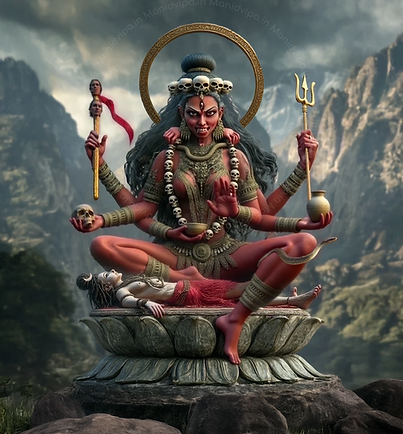
Para, Parāpara, and Aparā:
The Three Goddesses of Trika Śaivism
In the Trika school of Kashmir Śaivism, Parā, Parāparā, and Aparā are both intellectual categories and representations of divine energy. They appear as three goddesses who represent various levels of reality and consciousness, and they are worshipped as sovereign deities inside tantric ritual structures.
The trinity of Parā, Parāparā, and Aparā is first mentioned in Kashmiri Śaivism's Trika texts, including Abhinavagupta's Tantrāloka and the Parātrīśikā. The term "Trika" initially referred to the gathering of three goddesses—Parā, Parāparā, and Aparā—before being used to symbolize the broader philosophical philosophy. The Trishulabja Mandala (seen above) depicts the three forms of Śakti, represented by the three prongs of the trident.
Śiva and Śakti are inextricably linked, resulting in the trinity. Parā is the purest form of Śakti, followed by Parāparā, the transitional energy, and finally by Aparā, the completely differentiated and manifest form.
References and Sources:
-
Raffaele Torella, “The Trika Śaivism of Kashmir” – in Encyclopedia of Indian Philosophies, Vol. VIII (Pratyabhijñā philosophy and Trika system).
-
André Padoux, Vac: The Concept of the Word in Selected Hindu Tantras – discusses Parā as the supreme speech (parā vāk) and its role in Kashmir Śaivism.
-
Mark Dyczkowski, The Doctrine of Vibration: An Analysis of the Doctrines and Practices of Kashmir Shaivism – covers the triadic unfolding of Śakti.
-
J. Singh (trans.), Parā-trīśikā Vivaraṇa of Abhinavagupta – English translation with notes on Parā, Parāparā, and Aparā.
-
Wisdomlib – detailed definitions of Parāparā and related entries in Śaivism and Śāktism.
👉 wisdomlib.org/definition/parapara
Note:
This content has been refined using AI-assisted proofreading tools for clarity and structure. However, all historical and cultural information presented is based on references and sources.



